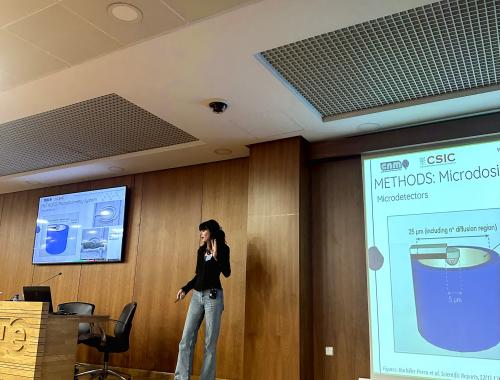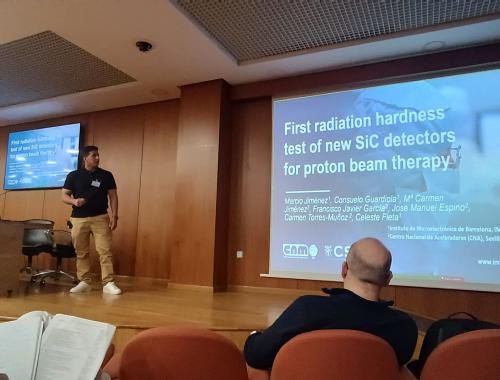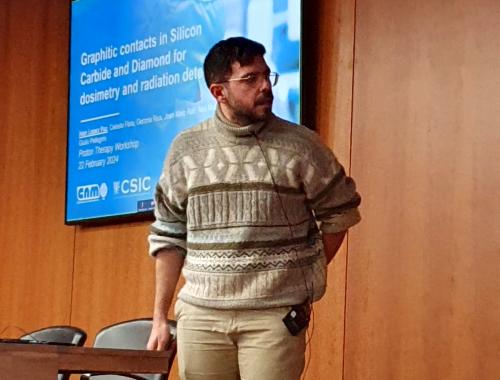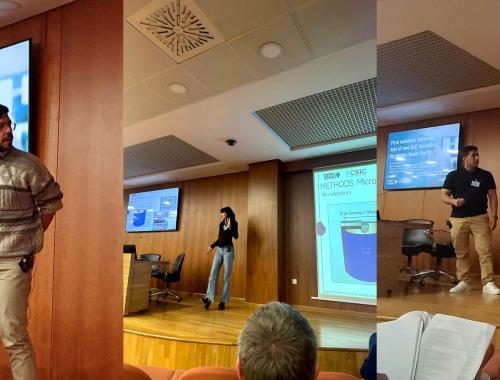Contribución del IMB-CNM al Workshop sobre Terapia de Protones en Valencia
A finales de febrero se celebró en Valencia el "Workshop on Technologies & Applied Research at the Future Valencian Proton-Therapy Facility". Reunió a los principales agentes y grupos de investigación implicados en la investigación de la terapia de protones en España y Europa. Consuelo Guardiola, investigadora del IMB-CNM, fue miembro del Comité Organizador liderando la contribución del instituto a las sesiones.
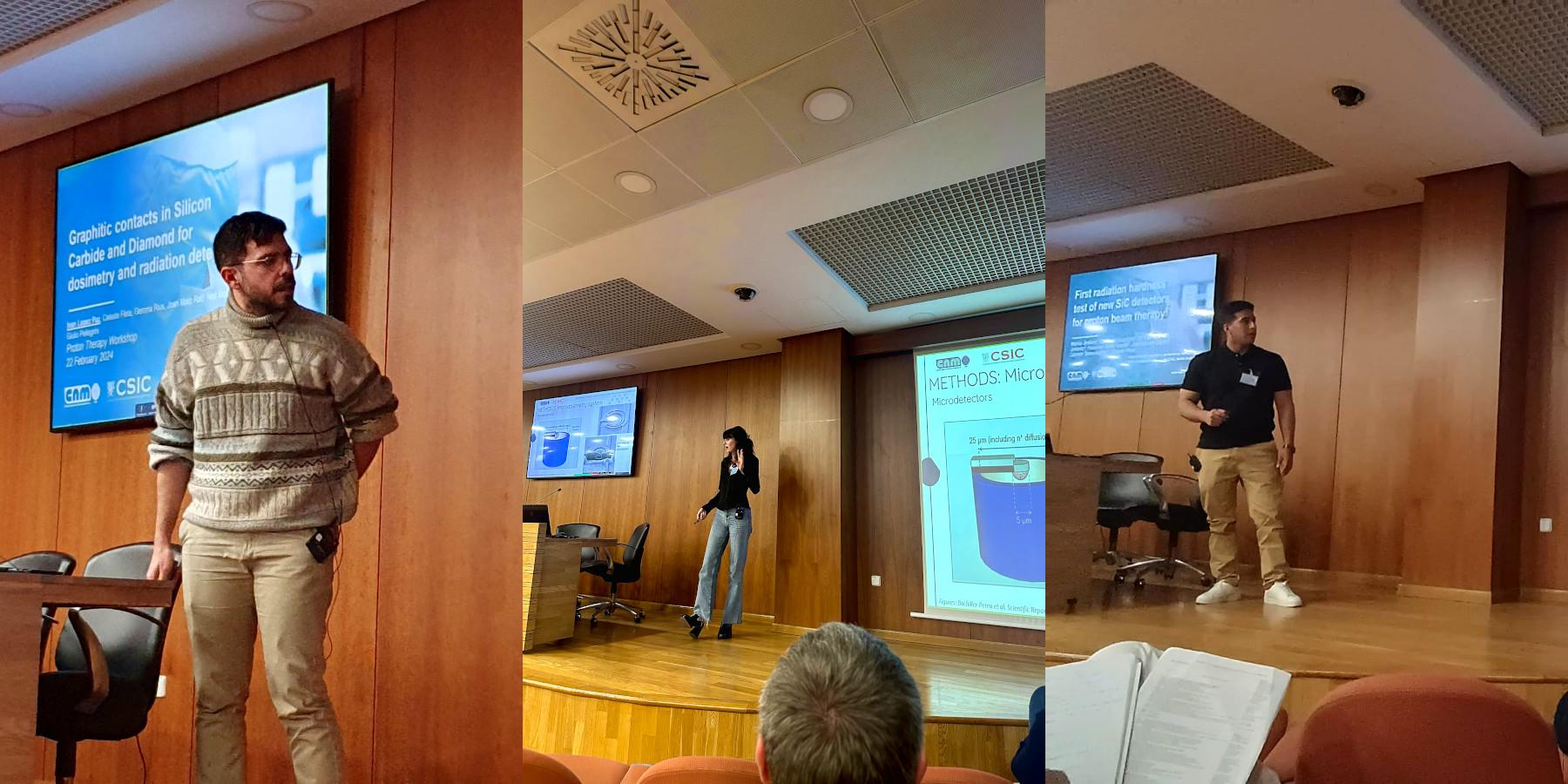
Consuelo Guardiola, investigadora del Instituto de Microelectrónica de Barcelona (IMB-CNM-CSIC) que trabaja en protonterapia, fue miembro del Comité Organizador del Workshop on Technologies & Applied Research at the Future Valencian Proton-Therapy Facility, celebrado en Valencia del 21 al 23 de febrero.
El objetivo de las jornadas era fomentar la colaboración y la transferencia de conocimiento entre la comunidad clínica y científico-tecnológica y diseñar estrategias para optimizar el uso de la futura red de 10 nuevas instalaciones de protonterapia en España, tanto en términos de tratamiento clínico como de aplicaciones de investigación e innovación. Otro objetivo crucial del taller es fomentar y facilitar la colaboración y comunicación con expertos mundiales en el campo de la terapia de protones, que cuentan con una sólida experiencia tanto en aspectos clínicos como tecnológicos. En consecuencia, el taller contó con la participación de un panel científico internacional compuesto por expertos de Alemania, Francia, Reino Unido, Polonia, Portugal y Suiza.
Guardiola también actuó como moderadora de la Sesión sobre "Investigación Aplicada en Monitorización de Tratamientos y Dosimetría" y otros tres miembros del Grupo de Detectores de Radiación expusieron sus investigaciones en sesiones paralelas: los investigadores predoctorales Carla Riera-Llobet y Marcio Alfonso Jiménez Venegas y el investigador postdoctoral Iván López Paz. Las siguientes descripciones proceden de sus resúmenes.
Los abstracts se mantienen en el idioma original.
First microdosimetry maps in low energy proton beams
Carla Riera-Llobet
Around 40% of people surviving cancer do so because of radiotherapy. However, to improve this statistic, treatments based on hadron radiotherapy (HT) are rapidly expanding worldwide. HT achieves very high dose conformity around the tumor target, allowing better protection of the organs at risk. This is particularly critical for radioresistant tumors, for tumors localized near organs at risk, and for pediatric cancers. Nevertheless, some toxicities have recently been reported.
It might be because ions deliver higher linear energy transfer (LET), which may generate collateral damages, e.g., acute and late effects, and even secondary cancer induction. However, there are no tools capable of measuring LET during treatments. In this context, the Institute of Microelectronics of Barcelona (IMB-CNM) has designed and manufactured new silicon 3D detectors based on a novel architecture of cylindrical electrodes with microscopic sizes as those from a cellular level. This allows quantifying the LET at micrometer scale, namely lineal energy.
Moving towards their clinical implementation requires designing large layouts covering several centimeters based on these successful prototypes and performing significant pre-clinical trials. The advanced detectors could also be used for beam monitoring and dose evaluation during radiobiology trials in real-time. The present work shows the performance of the first multi-pad-type array of those 3D microdetectors.
First radiation hardness tests of new silicon carbide dosimeters for proton beam therapy
Marcio Alfonso Jiménez Venegas
Proton therapy is an important radiotherapy that achieves very high dose conformity around the target, allowing a better protection of the organs at risk (decreasing radiation side effect). However, the dose delivered to a tumor is still conditioned by the dose that can be tolerated by the surrounding normal tissues. An emerging approach called FLASH therapy delivers a therapeutic dose several orders of magnitude faster than in current clinical cases.
The physical properties of silicon carbide (SiC) make it an interesting material for radiation dosimetry. The wide SiC band-gap decreases the rate of thermally generated charge carriers, reducing the leakage current and the noise compared to silicon. It also makes SiC essentially insensitive to visible light and temperature variations. SiC has a higher displacement energy threshold and thus a higher radiation hardness than silicon, and has a higher thermal conductivity which makes it more resistent to thermal shocks.
At IMB-CNM we have designed and fabricated novel silicon carbide PiN diodes with the aim to respond to the technological challenges of new radiotherapy approaches such as proton therapy and FLASH therapy and have performed their validation in relevant beams. For example, in a first characterization with FLASH electron beams, these diodes have shown their suitability for relative dosimetry up to a dose per pulse of 11 Gy. These devices were tested at the CNA in Sevilla, with the aim of studying their signal response, sensitivity and radiation hardness.
Study of epitaxial graphene contacts for Silicon Carbide radiation dosimetry and detection
Iván López Paz
Silicon Carbide (SiC) is a radiation hard wide bandgap semiconductor, which makes it an interesting alternative for radiation detection applications such as radiotherapy instrumentation. Reducing the amount of metal over the active can positively affect the accuracy of the measurement.
The first SiC diodes with epitaxial graphene contacts were produced at IMB-CNM for radiation detection. These detector prototypes have been characterized by means of a pulsed laser transient current measurement and a radioactive alpha source, showcasing the charge collection properties. These measurements have been followed by a characterization by means of a Linac at the University of Santiago de Compostela. These show a percent-level dose rate linearity of the prototypes, which is promising for future iterations for the medical application.





